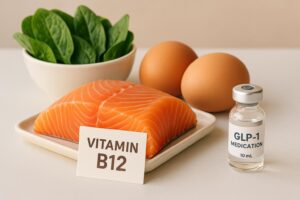How to Activate GLP-1 Naturally: A Comprehensive Guide

Introduction
Did you know that our bodies are equipped with a powerful hormone that can help regulate appetite and blood sugar levels? This hormone, known as glucagon-like peptide-1 (GLP-1), has gained significant attention recently, especially in the context of weight management and metabolic health. In a world where weight-related issues are increasingly prevalent, understanding how to harness the body’s natural mechanisms for appetite regulation is more crucial than ever.
GLP-1 is produced in the gut and plays a multifaceted role in our physiology. It not only stimulates insulin secretion—helping to lower blood sugar—but also slows down gastric emptying and reduces appetite, creating a feeling of fullness. This means that higher levels of GLP-1 can aid in weight loss and improve metabolic health.
In this blog post, we will explore various natural methods to activate GLP-1 in our bodies. By the end, you will gain insights into dietary choices, lifestyle modifications, and the role of gut health in boosting GLP-1 levels. Together, we’ll uncover how simple changes can lead to significant improvements in your overall well-being and weight management.
Our exploration will cover the following topics:
- Understanding GLP-1 and its Functions
- The Impact of Diet on GLP-1 Production
- The Role of Gut Health in GLP-1 Activation
- Lifestyle Changes to Enhance GLP-1 Levels
- The Importance of Personalized Approaches
Let’s dive in and discover how we can naturally activate GLP-1 to support our health and wellness journey!
Understanding GLP-1 and its Functions
GLP-1 is a hormone produced by specialized cells in the intestinal lining. It plays several essential roles in our body, including:
1. Insulin Secretion
Upon eating, GLP-1 is released and stimulates the pancreas to produce insulin. Insulin helps lower blood sugar levels by facilitating the uptake of glucose into cells, thereby providing energy.
2. Appetite Regulation
One of GLP-1’s key functions is to signal to our brain when we are full. It interacts with specific receptors in the brain, which can help reduce hunger and prevent overeating.
3. Slowing Gastric Emptying
GLP-1 slows the rate at which food leaves the stomach. This effect prolongs the feeling of fullness and helps stabilize blood sugar levels after meals.
4. Glucagon Regulation
GLP-1 also inhibits the release of glucagon, a hormone that raises blood sugar levels. By keeping glucagon levels in check, GLP-1 contributes to overall metabolic balance.
By understanding these functions, we can appreciate the importance of maintaining healthy GLP-1 levels for weight management and metabolic health.
The Impact of Diet on GLP-1 Production
Diet plays a crucial role in the natural activation of GLP-1. Certain foods can stimulate its production, while others may not have the same effect. Here are some dietary strategies to enhance GLP-1 levels:
1. High-Fiber Foods
Research indicates that dietary fiber is a significant player in GLP-1 activation. Foods rich in soluble fiber, such as oats, barley, and legumes, can promote the production of GLP-1. Fiber slows digestion, resulting in a gradual release of glucose and a sustained GLP-1 response.
Examples of High-Fiber Foods:
- Oats: A staple breakfast option, oats are rich in beta-glucan, which has been shown to stimulate GLP-1.
- Legumes: Beans, lentils, and chickpeas are excellent sources of protein and fiber that can help enhance GLP-1 levels.
- Fruits and Vegetables: Incorporating a variety of fruits and vegetables into your meals can boost fiber intake and support GLP-1 production.
2. Protein Sources
Including adequate protein in our diet can also support GLP-1 secretion. Foods like eggs, fish, chicken, and dairy products have been associated with increased GLP-1 levels.
3. Healthy Fats
Healthy fats, particularly those found in avocados and nuts, can stimulate GLP-1 production. These fats not only provide essential nutrients but also help enhance satiety.
4. Fermentable Fibers
Fermentable fibers, such as inulin and fructooligosaccharides, can be beneficial for GLP-1 activation because they are broken down by gut bacteria, leading to the production of short-chain fatty acids (SCFAs) that stimulate GLP-1 release.
Summary of Dietary Strategies
To boost GLP-1 levels naturally, focus on incorporating high-fiber foods, adequate protein sources, and healthy fats into your meals. This combination not only promotes satiety but also supports overall metabolic health.
The Role of Gut Health in GLP-1 Activation
A healthy gut microbiome is essential for optimal GLP-1 production. The trillions of microorganisms living in our intestines play a vital role in digestion and metabolism. Here’s how gut health influences GLP-1 activation:
1. Short-Chain Fatty Acids (SCFAs)
When gut bacteria ferment dietary fiber, they produce SCFAs, such as acetate, propionate, and butyrate. These SCFAs can stimulate GLP-1 secretion, making fiber-rich diets crucial for gut health and GLP-1 activation.
2. Indoles
Certain gut bacteria can convert tryptophan, an amino acid found in various foods, into indoles. These compounds can enhance GLP-1 production and promote gut health.
3. Gut Microbiome Diversity
Research shows that a diverse gut microbiome is associated with better metabolic health. A varied diet rich in different types of fiber can support the growth of beneficial bacteria that promote GLP-1 secretion.
4. Probiotics
Incorporating probiotics into your diet can further enhance gut health. Probiotic strains, such as Lactobacillus and Bifidobacterium, can increase SCFA production and, consequently, GLP-1 levels.
Summary of Gut Health Strategies
To improve gut health and activate GLP-1 naturally, consider incorporating prebiotic and probiotic foods into your diet. Focus on increasing diversity in your fiber intake to support a healthy gut microbiome.
Lifestyle Changes to Enhance GLP-1 Levels
In addition to dietary changes, certain lifestyle modifications can also play a significant role in activating GLP-1. Here are some effective strategies:
1. Regular Physical Activity
Exercise has been shown to enhance GLP-1 levels. Engaging in regular physical activity, such as aerobic exercises and strength training, can improve insulin sensitivity and promote metabolic health. Aim for at least 150 minutes of moderate-intensity exercise each week.
2. Stress Management
Chronic stress can negatively impact hormone balance, including GLP-1. Incorporating stress-reducing techniques such as mindfulness, yoga, or meditation can help maintain a healthy hormonal environment conducive to GLP-1 activation.
3. Quality Sleep
Getting enough restorative sleep is essential for overall health, including hormone regulation. Poor sleep can disrupt hormonal balance and lead to increased cravings and appetite. Aim for 7-9 hours of quality sleep each night to support GLP-1 levels.
4. Staying Hydrated
Adequate hydration is crucial for metabolic functions. Drinking enough water throughout the day can support digestion and may help in regulating appetite.
Summary of Lifestyle Strategies
Incorporating regular exercise, managing stress, prioritizing quality sleep, and staying hydrated can contribute significantly to naturally activating GLP-1 and improving overall health.
The Importance of Personalized Approaches
At TrimRx, we recognize that each individual’s journey to health and weight management is unique. Our commitment to personalized care reflects our understanding that a one-size-fits-all approach doesn’t work for everyone.
Tailored Nutrition
By taking our free assessment quiz, you can receive personalized recommendations tailored to your unique metabolic profile and lifestyle. This assessment can help identify the most effective dietary strategies to activate GLP-1 naturally, considering your individual preferences and health goals.
Supportive Environment
Additionally, partnering with our team at TrimRx provides you with access to compassionate support, guidance, and resources designed to help you navigate your weight loss journey. Our focus on science, empathy, and transparency ensures that you receive the individualized care you deserve.
Summary of Personalized Approaches
Finding personalized strategies to activate GLP-1 and support your health journey is essential. By embracing tailored nutrition and working with a supportive team, you can make sustainable changes that lead to lasting results.
Conclusion
In conclusion, activating GLP-1 naturally is a multifaceted process that involves dietary choices, lifestyle modifications, and a healthy gut microbiome. By focusing on high-fiber foods, adequate protein sources, healthy fats, and maintaining a balanced gut, we can enhance GLP-1 production and improve our overall metabolic health.
Incorporating regular exercise, managing stress, prioritizing quality sleep, and staying hydrated can further support this hormone’s activation. At TrimRx, we believe in the power of personalized care to help individuals achieve their health and weight management goals.
As you embark on your journey to activate GLP-1 naturally, consider taking our free assessment quiz to discover tailored recommendations that suit your individual needs. Together, we can explore the path to a healthier, more fulfilling life.
FAQ
What is GLP-1, and why is it important?
GLP-1 is a hormone produced in the gut that plays a crucial role in regulating blood sugar levels, appetite, and digestion. It helps stimulate insulin secretion, slows gastric emptying, and reduces hunger, making it important for weight management and metabolic health.
How can I increase my GLP-1 levels naturally?
To boost GLP-1 levels naturally, focus on a diet rich in fiber, protein, and healthy fats. Incorporate high-fiber foods like whole grains, legumes, fruits, and vegetables, and consider adding probiotics to support gut health.
Does exercise help activate GLP-1?
Yes, regular physical activity has been shown to enhance GLP-1 levels. Aim for at least 150 minutes of moderate-intensity exercise each week to support metabolic health.
Can stress affect GLP-1 production?
Chronic stress can disrupt hormonal balance, including GLP-1. Managing stress through techniques like mindfulness and yoga can help maintain a healthy hormonal environment.
Why is personalization important in weight management?
Personalization is crucial because each individual has unique metabolic profiles, preferences, and health goals. Tailored approaches can lead to more effective and sustainable results in weight management.
By understanding how to activate GLP-1 naturally, we can take proactive steps toward better health and weight management. Let’s embrace this journey together!

Transforming Lives, One Step at a Time
Keep reading
Vitamin B12 and GLP-1 Medications: What to Know
GLP-1 medications can lower B12 absorption and intake; learn symptoms, food sources, supplement options, and how to monitor levels.
Semaglutide Injection Site Reactions: What To Know
Learn why semaglutide injections can cause redness, swelling or nodules, how to prevent and treat them, and when to seek medical care.
TrimRx vs Friday’s
Compare TrimRx and Friday’s telehealth GLP-1 weight-loss programs: pricing, medical support, coaching, delivery, and which fits your needs.



